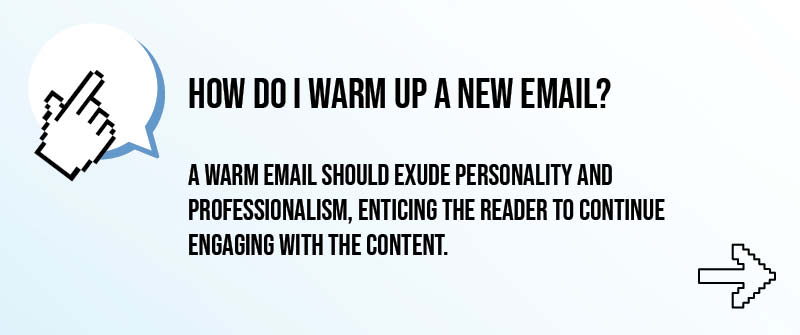AudiencePoint is thrilled to announce our new integration with Klaviyo! AudiencePoint is looking for partners to pilot our...
How to Properly Warm Up an Email?
The email warm-up process is crucial for any email marketer aiming to improve deliverability rates and maintain a strong sender reputation. Proper email warmup ensures that your emails land in the inbox, rather than the spam folder, by gradually establishing trust with internet service providers (ISPs). This process helps with inbox placement by boosting the likelihood that your messages reach the intended recipients’ main inbox, enhancing the visibility and effectiveness of your campaigns, increasing positive sending reputation, and reducing the chances of invalid email addresses.
Importance of Email Warmup
Email warmup is important because it helps to incrementally increase your sending volume over a period of time. This strategy allows ISPs to recognize your domain/IP as legitimate and improves email deliverability, lowering the chances of your emails being flagged as spam. Without proper email warmup, even well-crafted emails are at risk of being overlooked or delivered to the wrong folder.
Step-by-Step Guide To Warm Up Your Email
Begin by sending a low volume of emails to engaged recipients who are likely to open and interact with your content. After a few days, incrementally increase the number to expand your reach. Use an automated email warm-up tool to automate and track this process effectively. Tools can help monitor your email health and provide insights into engagement metrics.
Common Mistakes to Avoid During Email Warmup
One common mistake that can hinder a successful email warm-up is ramping up email volume too quickly. This can raise red flags with ISPs and harm your sender’s reputation. Ensure you have a verified sender address and use authenticated domains to prevent deliverability issues. Avoid sending to inactive or purchased lists, as these can cause high bounce rates and negatively impact your efforts.
How Do I Warm Up a New Email?
Warming up a new email account is a crucial step in ensuring that your emails reach your audience’s inbox and not their spam folder. Starting from scratch requires a strategic approach to build a credible sender reputation. Let’s delve into the essentials of warming up a new email and the tools that can make the process seamless and cost-effective.

Understanding the Setup for a New Email Address
Before you begin sending emails, it’s important to set up your new email address correctly. This involves ensuring proper authentication protocols like SPF, DKIM, and DMARC (domain based message authentication) are in place to avoid triggering spam filters. These measures help email providers verify your identity and establish your email domain’s credibility, which forms the foundation of a successful email warm-up.
Best Free Tools for New Email Warmup
Fortunately, there are numerous free tools available that can assist in warming up your new email. These tools simulate natural sending patterns by gradually increasing the number of emails sent over time and monitoring deliverability performance. By sending real, engaging content in these warm-up emails, you can encourage responses and build your email sender’s reputation more effectively. Some notable free options include Mailwarm, GMass, and SendGrid’s email warm-up tool. These platforms offer basic functionalities that can support beginners in their email warm-up journey without incurring costs.
Timeline for Effective Warmup
The duration of the warm-up process of an email varies, typically ranging from a few weeks to a couple of months. It starts with sending small batches of emails to engaged subscribers and slowly ramping up the volume. Patience is key, as a rushed process can lead to your emails being flagged as spam. Consistency and gradual scaling are critical to developing a strong, reputable sender profile.
Is Email Warm Up Legal?
Overview of Email Marketing Regulations
Email warm-up, like all email marketing strategies, is subject to various regulations designed to protect consumers against unsolicited messages. Different countries have specific laws that govern how emails should be sent, collected, and managed. In the United States, the CAN-SPAM Act establishes standards for sending commercial emails, grants recipients the right to have emails stopped from being sent to them, and spells out penalties for violations. Similarly, the General Data Protection Regulation (GDPR) applies to entities that process data of EU residents, focusing on user consent and data privacy.
Legal Considerations for Email Warmup
To ensure that your IP warming strategy remains within legal bounds, it is essential to establish a foundation of explicit consent from your subscribers before including them in any cold email campaigns. This involves obtaining permission from individuals to contact them, which not only adheres to legal requirements but also bolsters engagement rates due to a likely interest in receiving your communications. Furthermore, ensuring accurate records of consent and following best practices in list management helps mitigate risks associated with legal non-compliance.
Ensuring Compliance in Email Warmup Practices
Compliance in email warm-up not only prevents legal repercussions but also enhances overall deliverability and sender reputation. Adhering to a compliance checklist, such as using secure signup methods, giving recipients clear unsubscribe options in every email, and avoiding misleading subject lines and headers, will sustain your long-term IP warming efforts. By following these practices, companies demonstrate their commitment to data protection and consumer preferences, which ultimately builds trust with both ISPs and recipients.
Don’t have time for email warmup tools? Check out email warming services and find out if email warming services work?
How Do You Write a Warm Email?
Writing a warm email is a critical skill that email marketers and digital marketing professionals must master to foster engagement and drive conversions, especially when transitioning from cold emailing. A warm email should exude personality and professionalism, enticing the reader to continue engaging with the content.

Crafting Engaging and Personalized Content
The first step in creating an effective warm email or executing successful cold emails is to ensure the content is engaging and personalized. Start by using the recipient’s name and other personal information where possible. This simple touch can make a significant difference in how your email is received. Furthermore, it’s critical to tailor the content of your email to address specific interests or pain points of your audience. Using segmentation tools can greatly assist in delivering more targeted and personalized emails.
Tips for Maintaining a Professional Tone
Maintaining a professional tone while writing a warm email is essential. While it’s important to be personable, professionalism must not be compromised. Avoid overly casual language and slang. Instead, focus on clear and concise communication. A balance between friendliness and professionalism ensures that your message is not only read but respected.
Examples of Successful Warm Emails
Consider examples where companies have successfully leveraged email personalization for better engagement. For instance, brands that use dynamic content based on user behavior or historical data tend to see higher open rates and more clicks. Analyze these successful emails as a source of inspiration, noting the elements that create warmth and engagement.
Conclusion: Choosing the Best Email Warm-Up Tool
The journey to successful email marketing begins with selecting the best email warm-up tools that align with your business goals. Email warm up helps you create effective long term campaigns, and understanding what makes a tool stand out among others is crucial for achieving optimal results.
Comparison of Top Email Warm-Up Tools
When evaluating email warm-up tools, it’s important to compare their features, usability, and integration capabilities. Essential features to look for include automation of warm-up processes, tracking engagement metrics, and ensuring emails are marked as important by the recipients’ email clients. Some tools provide a comprehensive dashboard that allows you to monitor real-time data insights, which can significantly contribute to improving deliverability rates.
A key aspect of comparison also lies in the support and resources offered by the provider. Tools that offer robust customer support and educational resources can greatly simplify the learning curve and ensure you get the most out of the service.
Factors to Consider When Selecting a Tool
Selecting an email warm-up tool requires a thorough consideration of your objectives and infrastructure. You should assess the level of customization available within each tool to accommodate specific industry needs and ensure that it does not trigger spam filters. Additionally, the complexity of the tool and its alignment with your existing email service provider (ESP) are critical considerations that influence ease of integration and overall efficacy.
Cost-effectiveness is another key factor. Some tools offer tier-based pricing, which can be beneficial if you need flexibility to adjust as per your usage scale. Ensure that your chosen tool can also grow with your company, offering more advanced features as your needs evolve.
Benefits of Using the Right Email Warm-Up Tool
The right email warm-up tool doesn’t just automate the initial stages of email marketing; it optimizes entire processes to enhance engagement and deliverability. By leveraging the appropriate tool, you can significantly reduce the time required for IP warming and focus on strategy rather than manual monitoring, thereby driving more efficient email campaigns.

Unlock unparalleled insights into your subscribers’ inbox habits with AudiencePoint. Employ the leading email platform designed to boost re-engagement, enhance deliverability, and catalyze revenue growth through sophisticated data tracking and analysis. Make informed decisions by viewing our demo and discover how our powerful tools can elevate your email marketing efforts to the next level. Contact AudiencePoint today!





